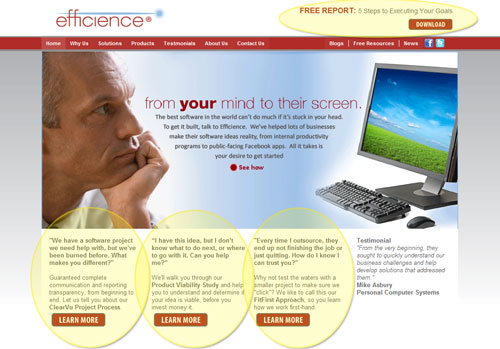Our Marketing Revolution Continues
I previously wrote about our efforts to improve our marketing material, to stop talking so much about ourselves and start talking about how to solve our clients’ pains. A company called Square2Marketing (writers of Reality Marketing Revolution)has been helping us make these changes, and that over time I would update on the progress. The time has come for an update…
Our website is the first major change we’ve made. It is still a work in progress, but we’ve taken some huge strides towards where we want to be. We’ve defined the most common pains of our clients and have really focused on addressing those pains on the website, starting right on the home page. We are continuing to build content that will be more informative to our potential clients, which is key. I think of it like having a storefront with a big sign in the window: if no one that sees the sign bothers to come in and look around or do business, does it do any good to have the sign?
At efficience.us, we point out the pains that our clients face and the solutions we have for those pains. Providing information and education around these pains like we’ve done right on the home page (see below) is a huge focus point. This is followed up inside the site with our “remarkables”, or unique solutions for solving those pains.
Offering valuable, interesting information online for free, aka No Risk Offers, allows us to get our content out to people that are interested in what we have to offer. At the same time we are building an email base of potential clients that we can market to with things such as educational webinars, lunch & learns, videos and Facebook. Having 50 highly qualified potential clients is much more beneficial than 200 that would not likely use your services. Knowing who your potential clients are makes it easy to stay in front of them by sending out monthly datasheets, newsletters, or industry stats…keeping them reminded of you and informed.
This is all part of the marketing plan that we’re working on, adding more remarkable content as we go. We migrated my blog to our website a while ago, we have added the blogs of team members, and will soon be adding an Efficience blog that we will all contribute to. We are really happy with the changes we’ve made so far and excited about the additional changes coming. I’ll keep you posted on the evolution of our marketing strategy and how these changes are working to help our business.






